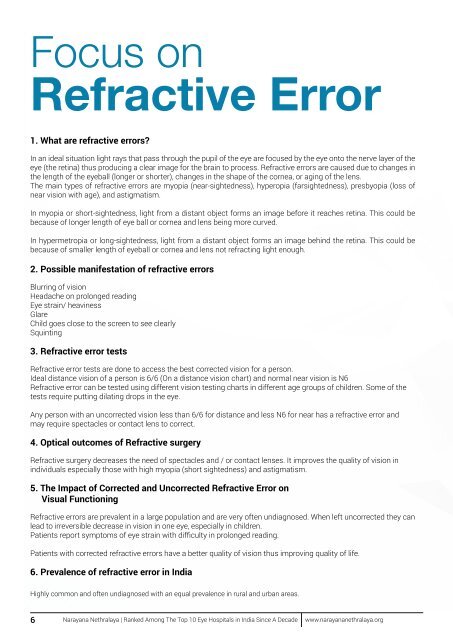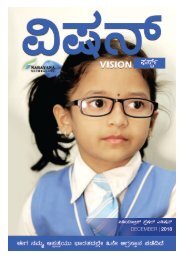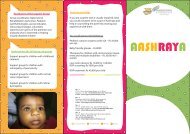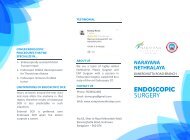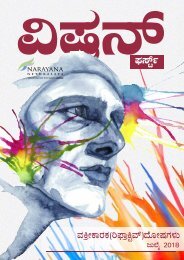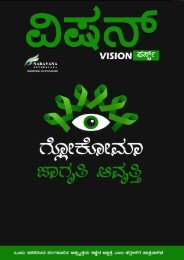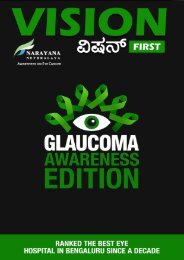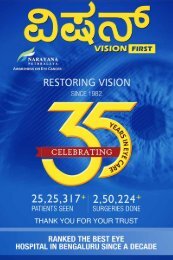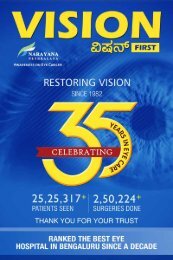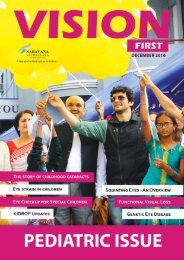Vision First July 2018 English
You also want an ePaper? Increase the reach of your titles
YUMPU automatically turns print PDFs into web optimized ePapers that Google loves.
Focus on<br />
Refractive Error<br />
1. What are refractive errors?<br />
In an ideal situation light rays that pass through the pupil of the eye are focused by the eye onto the nerve layer of the<br />
eye (the retina) thus producing a clear image for the brain to process. Refractive errors are caused due to changes in<br />
the length of the eyeball (longer or shorter), changes in the shape of the cornea, or aging of the lens.<br />
The main types of refractive errors are myopia (near-sightedness), hyperopia (farsightedness), presbyopia (loss of<br />
near vision with age), and astigmatism.<br />
In myopia or short-sightedness, light from a distant object forms an image before it reaches retina. This could be<br />
because of longer length of eye ball or cornea and lens being more curved.<br />
In hypermetropia or long-sightedness, light from a distant object forms an image behind the retina. This could be<br />
because of smaller length of eyeball or cornea and lens not refracting light enough.<br />
2. Possible manifestation of refractive errors<br />
Blurring of vision<br />
Headache on prolonged reading<br />
Eye strain/ heaviness<br />
Glare<br />
Child goes close to the screen to see clearly<br />
Squinting<br />
3. Refractive error tests<br />
Refractive error tests are done to access the best corrected vision for a person.<br />
Ideal distance vision of a person is 6/6 (On a distance vision chart) and normal near vision is N6<br />
Refractive error can be tested using different vision testing charts in different age groups of children. Some of the<br />
tests require putting dilating drops in the eye.<br />
Any person with an uncorrected vision less than 6/6 for distance and less N6 for near has a refractive error and<br />
may require spectacles or contact lens to correct.<br />
4. Optical outcomes of Refractive surgery<br />
Refractive surgery decreases the need of spectacles and / or contact lenses. It improves the quality of vision in<br />
individuals especially those with high myopia (short sightedness) and astigmatism.<br />
7. How to prevent vision loss among children and adolescents due<br />
to refractive errors?<br />
Uncorrected refractive errors in children can cause lazy eye. One of the key ways to avoid vision loss in children is<br />
the early detection of refractive errors . This can be achieved if there is enough awareness about paediatric refractive<br />
errors amongst parents and caretakers. Regular eye check-up’s , evaluation for even minor degrees of squinting , good<br />
compliance to patching therapy for the lazy eye can avoid vision loss amongst children and adolescents .<br />
8. Can you be short and long sighted at the same time?<br />
The same eye can’t be long-sighted and short-sighted at the same time. The confusion arises from mistaking presbyopia<br />
with long-sightedness. Presbyopia can affect your distance and reading vision and usually occurs after the age of 40<br />
years<br />
9. What is Laser <strong>Vision</strong> Correction? What are the benefits of Laser <strong>Vision</strong> Correction?<br />
Laser <strong>Vision</strong> Correction is a type of surgery which is done by applying a laser to reshape the cornea, the clear front part<br />
of the eye, so that light traveling through it is properly focused onto the retina located in the back of the eye.<br />
10. What is astigmatism?<br />
An irregularly shaped cornea or lens prevents light from focusing properly on the retina, the light-sensitive surface at the<br />
back of the eye. As a result, the image seen is perceived as blurred or distorted by the eye because of altered focusing<br />
of light in a particular axis(meridian). This is known as astigmatism.<br />
Due to imperfection of the Cornea, farsightedness (hyperopia) and short sightedness (myopia) occurs, and can co exist<br />
with astigmatism.<br />
11. What is Anisometropia of the eye?<br />
Anisometropia is the condition in which the two eyes have significantly unequal refractive power.<br />
12. What is presbyopia? What are the symptoms, causes, diagnosis, treatment, cure, correction,<br />
surgery, prevention & excercises?<br />
Presbyopia is a process of aging of the eye wherein the lens loses its flexibility and is now unable to focus near objects<br />
.Inability to read comfortably and needing to keep the material at an increased distance, are the main symptoms of<br />
presbyopia. Normally it starts after 40 years of age.<br />
Near vision testing using different charts like Snellen’s near vision chart can pick up this. Eye glasses with bifocal or<br />
progressive lenses would be the usual and most common resolution to these issues. If people do not prefer to wear<br />
glasses they have the option of contact lenses. Refractive surgery for presbyopia is also available for people who do not<br />
wish for either glasses or contact lenses.<br />
5. The Impact of Corrected and Uncorrected Refractive Error on<br />
Visual Functioning<br />
Refractive errors are prevalent in a large population and are very often undiagnosed. When left uncorrected they can<br />
lead to irreversible decrease in vision in one eye, especially in children.<br />
Patients report symptoms of eye strain with difficulty in prolonged reading.<br />
Patients with corrected refractive errors have a better quality of vision thus improving quality of life.<br />
6. Prevalence of refractive error in India<br />
Highly common and often undiagnosed with an equal prevalence in rural and urban areas.<br />
6 Narayana Nethralaya | Ranked Among The Top 10 Eye Hospitals in India Since A Decade www.narayananethralaya.org Narayana Nethralaya | Ranked Among The Top 10 Eye Hospitals in India Since A Decade www.narayananethralaya.org 7


